Do You Have the Rarest Eye Color? See the Statistics
December 22, 2023 • 11:46 PM
As a society, we romanticize the eyes. With expressions like, “Eyes are the windows to the soul” and “I can see it in your eyes,” we expect the eyes to tell us a lot. And while a person’s eye color won’t tell us what’s hidden in the depths of their soul, it can tell us ... something.
Eye color can tell us about a person’s ancestry. People with lighter eyes typically descend from darker, colder environments, like Northern Europe. And people with darker eyes typically descend from sunnier environments, like Africa, South America, Asia, and the Mediterranean.
But more than anything, eye color can tell us about the amount of melanin in someone’s irises. Yes, melanin, the samemolecule that determines the color of our skin and hair, also affects the pigment of our eyes. And the rarest eye colors — globally and in the United States — are the colors that come from having less melanin in your irises.
However, the data on what percentage of the world’s population has each eye color is limited and often excludes the most unique eye colors, like violet and gray. We’ll parse through the data that is available to determine the rarest eye color, and we’ll look at the factors that contribute to different eye colors.
What Is the Rarest Eye Color?
The rarest eye color is most likely red and violet (in people with albinism) or green (in the general population).
Studies on eye color are limited and most of them have been conducted in the United States and Europe where light eye colors, like blue and green, are more common than they are globally.
According to asurvey by the American Academy of Ophthalmology (AAO), eye color in the United States breaks down like this:
-
Brown eyes: 45%
-
Blue eyes: 27%
-
Hazel eyes: 18%
-
Green eyes: 9%
-
Another eye color: 1%
For many years, people have used this survey to say that green is the rarest eye color, but technically there is a tiny percentage of the population with even rarer eye colors — colors so rare they weren’t even listed in the survey. And again, because this survey was conducted in the U.S., it’s not representative of the whole world’s population.
Multiple studies (likethis one from 2019 andthis one from 2015) have shown that the most common eye color in Asia is brown. Nearly the entire population had brown eyes with a few rare occurrences of hazel or green eyes. The same was truein Africa, and we weren’t able to find any studies of eye color in South America.
Interestingly, the most commonly citedstudy on eye color in Europe only looks at blue eyes, brown eyes, and “intermediate” eyes.
Essentially, this study broke eye color down based on how much melanin was in the eyes. Blue eyes have no melanin. Brown eyes have lots of melanin. And all the eye colors in between fall on a sliding scale of more to less melanin.
They found that in Northern European countries, like Iceland, nearly 75% of the population had blue eyes. But in sunnier climates, like Armenia, about 80% of the population had brown eyes, and only 3% had blue eyes.
Why Do People Have Different Eye Colors?
The color of your eyes is affected by a variety of complex genetic factors with16 different genes playing a role. And while we used to believe that all blue-eyed parents would have blue-eyed children, the actual genetics are turning out to be much more complicated than that.
Researchers are still sorting through all of the genes that determine eye color and discovering how each one affects the human eye. But while it’s still early days for understanding the genetics of eye color, we do understand how eye colors work in action — it’s all that melanin we’ve been talking about.
Melanin adds dark pigmentation to the hair, skin, and irises (the colored part of the eyes). The irises have two layers. The back layer is called the pigment epithelium, and this layer is brown in nearly everyone. It’s the front layer, called the stroma, that determines the color of your eyes. The more melanin you have in your stroma, the darker your eyes will be.
We’ll look at each eye color, starting with the ones with the least melanin and working our way up to the ones with the most melanin.
Red and Violet Eyes
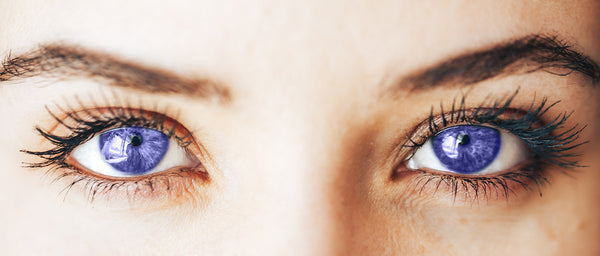
Red, pink, andpurple eyes can occur naturally in people withalbinism. Albinism is a genetic condition that makes it so a person’s body can’t produce melanin, which leads to a lack of pigment in their skin, hair, and eyes.
Most albino people have blue eyes. The stroma in blue eyes doesn’t contain any melanin, so no melanin typically means blue eyes. (Although, people with mild cases of albinism can also have hazel or brown eyes.)
But in some people with severe albinism, the pigment epithelium — the back part of the iris — isn’t as dark brown as in the general population. This allows blood vessels in the eyes to show through the irises, which can make the eyes look red or purple (the color you get when you mix red and blue).
The percentage of the population with albinism is estimated to be between 0.03% and 0.005%. And since not everyone with albinism has red eyes or violet eyes, the percentage of the population with these rare eye colors will be even smaller. So red and violet eyes are likely the rarest eye colors in the world.
Blue Eyes
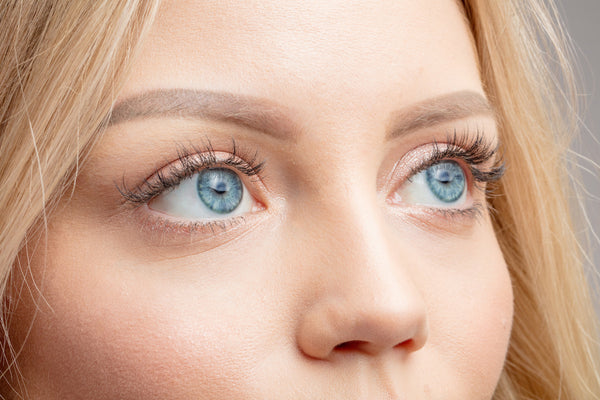
Get ready to have your mind blown: Blue eyes are actually clear eyes.
The stroma in blue eyes doesn’t contain any color pigment. The AAO believes that allblue-eyed people are descended from a common ancestor — an ancient human who was born with a genetic mutation that made it so his irises didn’t contain any pigmentation.
The lack of pigment in “blue” eyes allows the irises to reflect and scatter wavelengths of light from the environment. And it’s the shortest wavelength of light — blue light — that gets reflected the most and gives blue eyes their light blue tint.
This scattering of wavelengths is known as theRayleigh Scattering Effect. It’s the same thing that makes the sky and ocean appear blue, even though we all know that air and water are clear. So if you have blue eyes, you are one with the sky and sea.
Gray Eyes
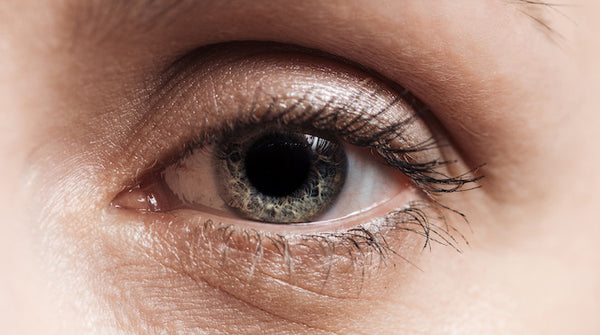
Like blue eyes, gray eyes don’t have any pigment, but they containmore collagen than blue eyes.
The collagen makes the light in the environment scatter more evenly — it’s similar to how the water in a storm cloud scatters light more evenly than an open sky.
So instead of reflecting one wavelength of light, gray eyes are reflecting all the wavelengths equally, giving them their stormy color. There isn’t good data on how rare gray eyes are, but they’re believed to be even rarer than green eyes.
Green Eyes
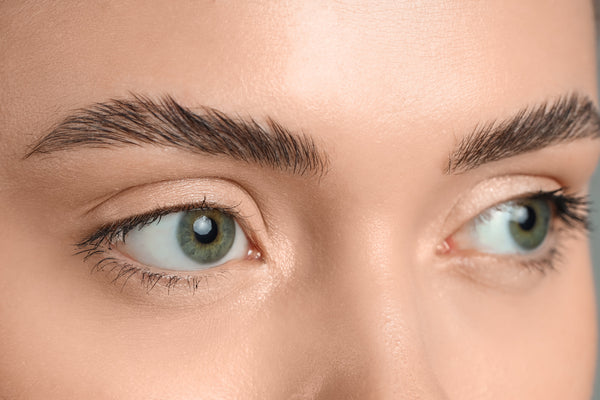
Long believed to be the rarest eye color,green eyes have just a tiny bit more melanin than blue eyes.
So when they pick up and reflect light from the environment, that light mixes with the small amount of melanin in the eyes and gets reflected back as a slightly darker color in the irises. It’s kind of like how ocean water cansometimes appear blue and sometimes appear green, depending on how much plant life is hiding below the surface.
Green eyes aremore common in women than in men, but researchers still don’t understand why.
Hazel Eyes
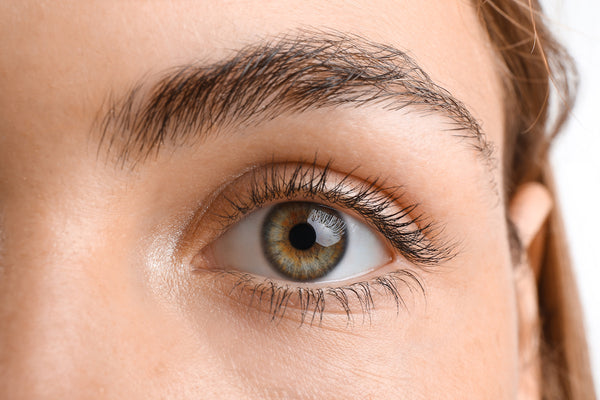
Hazel eyes have more melanin than green eyes but less melanin than brown eyes.
The brown pigment from the melanin is often distributed unevenly across the iris, which can make hazel eyes appear speckled with different shades of green, amber, and brown. And hazel eyes often appear to change color in different lighting.
Hazel eyes are uncommon in the United States — with less than 20% of the population claiming to have this eye color. But they may be more common on a global scale since the few people in Asia and Africa who don’t have brown eyes often have hazel eyes. But this eye color is still rare in these parts of the world.
Amber Eyes

Amber eyes — or eyes that have a glowing, golden hue — are more common in the animal kingdom than in people. You’ll often see them in lions, owls, and even snakes. But there are people who have this rare eye color.
We don’t have good data on what percentage of the world’s population has amber eyes. But like hazel eyes, amber eyes may be more common in parts of the world where most people have brown eyes. And because there isn’t as much data on eye color in these parts of the world, amber eyes may be under-represented in our statistics.
Like brown eyes, amber eyes contain a lot of melanin, but they contain a different type of melanin. Brown eyes come from high amounts of eumelanin, a dark brown pigment, while amber eyes come from pheomelanin (aka lipochrome), a reddish-brown pigment.
Brown Eyes

And finally, we come to the most common eye color, brown eyes. But before you think that “common” means this color isn’t special, think again. People evolved to primarily have brown eyes for a reason.
Brown eyes contain high amounts of melanin, which helps protect your eye from sun damage and the macular degeneration that can come from too much UV exposure. This was essential in the sunny African plains where the earliest humans lived, and this color can still protect your eyes in bright environments.
But if you’re going to be in bright sunlight for a long time, you should wearsunglasses to protect your eyes from UV radiation — even if you have brown eyes.
Heterochromia

Eyes come in many different colors, but usually, you’re limited to one eye color per person — unless you haveheterochromia.
People with heterochromia have two different-colored eyes. So their left eye may be green while their right eye is brown. Or their left eye may be hazel while their right eye is blue.
Heterochromia is extremely rare. It affects about 0.06% of people, making it just slightly more common than violet eyes. Most children born with heterochromia are perfectly healthy, but in rare cases, it can be a sign of an underlying health condition, likeHorner syndrome.
For adults who suddenly develop heterochromia, it’s more likely to be a sign of an underlying health problem, like an eye injury or infection, glaucoma, Horner syndrome, or diabetes. Make sure to consult with your doctor if one of your eyes changes color.
Can Your Eye Color Change?
Your eyes might look a little brighter or a little darker, depending on what you’re wearing and the lighting in your environment, but they shouldn’t completely change colors.
If you wake up one day with different colored eyes, it could be a sign of an underlying eye condition. Changes in eye color can be brought on by cataracts, diabetes, long-term use of glaucoma medication, inflammation of the iris, injury, and other conditions. So talk to your doctor immediately if your eyes suddenly change color.
If, on the other hand, you want to change the color of your eyes, you can do it at any time by wearing colored contact lenses.
We believe all eyes are beautiful, but we also understand wanting to change your look. (That’s why we created glasses where you can change the color of your frames whenever you want with snap-onTop Frames.)
For the sake of your eye health, however, you should only use contact lenses prescribed by your doctor. Even if you don’t need prescription vision correction, see your eye doctor to make sure your contact lenses are safe for your vision.
Bring Out Your Eye Color
While the global data on eye colors is limited, red and violet eyes are likely the rarest eye colors since they only affect a small group of people with albinism. But if you exclude eye colors brought on by albinism, then green and gray are likely the rarest.
And while we need more data to know which eye color is the rarest with absolute certainty, we do know this: Every eye color is beautiful. There’s beauty in variety.
That’s why we createdPair Eyewear to add more variety to your eyewear wardrobe. You can change the color of your frames anytime with our snap-on Top Frames andSun Tops. Choose fun colors and patterns that bring out your eyes. Because like your eye color, your eyewear should be uniquely you.